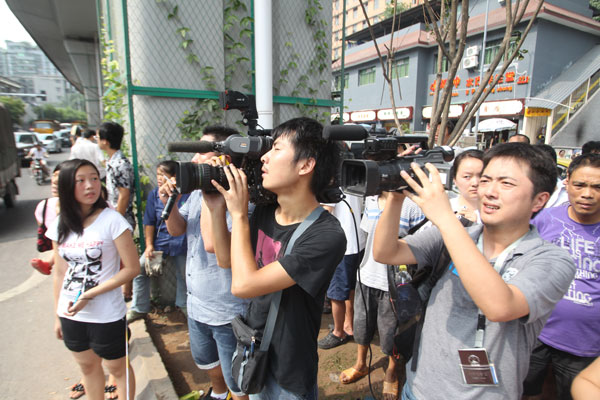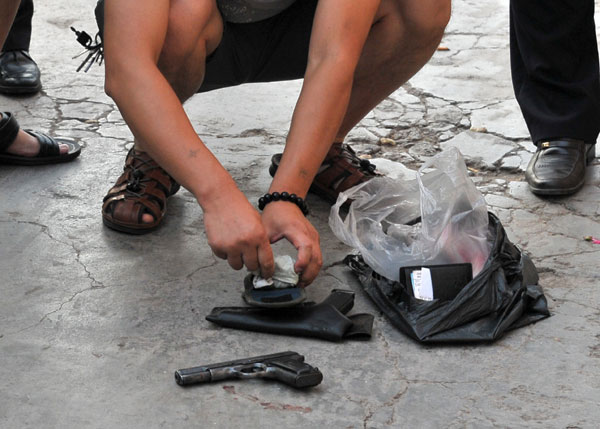Officers describe shooting of suspect
Updated: 2012-08-15 08:13
By Wu Wencong and Tang Yue in Beijing and Xu Wei in Chongqing (China Daily)
|
|||||||||||
Zhou Jin and Wang Xiaoyu, two police officers from the Chongqing Municipal Public Security Bureau, have told China Central Television about their gunfight with Zhou Kehua, who was suspected of killing 10 people in eight years, and how they finally shot him dead at around 6:50 am on Tuesday.
 |
|
Cameramen film at the site where Zhou Kehua was shot dead in Chongqing on Tuesday. Yang Fan / for China Daily |
 |
|
A police officer collects a gun used by Zhou Kehua and some of the suspected killer's other belongings at the site where police shot him dead on Tuesday in Chongqing. Xinhua |
Zhou Jin said they got information that after the suspect's last robbery outside a bank in Chongqing's Shapingba district, he would make "another hit".
In response, the two officers were asked to guard an area near a bank in Tongjiaqiao village, Shapingba, beginning at 6 am on Tuesday, following orders from the public security bureau.
"At about 6:45 am, a colleague called me from another spot nearby, saying that a man who looked like the suspect was heading in our direction," said Zhou Jin. "But he said the man was talking on his cellphone, and we knew that one of the suspect's habits was never to use a cellphone."
So Zhou Jin followed the suspect from behind, while Wang approached him from another direction. As they followed him, the suspect turned his head several times to look back, which made him more suspicious to Zhou Jin.
They followed him across a street into an alley, and he started to walk faster.
"We also sped up. After we had gone about 30 meters into the alley and the distance between him and us was around 10 meters, he suddenly turned back, murmuring, 'Did I go the wrong way?' and walked toward us," said Zhou Jin.
He said he was extremely tense when the suspect turned to him and his colleague, and he thought, "It must be him and he's going to shoot us.
"My gun was still in my pocket and unloaded. The moment I saw him reaching for his gun, I loaded mine and backed off for shelter," said Zhou Jin.
Wang said the suspect was only about 3 meters away from them when he started shooting. Zhou Jin hid behind a telegraph pole and Wang hid in a nearby corner.
"The three of us formed a triangle, with Zhou Jin and me in much better positions for a gunfight," said Wang. "We would cover each other in our positions easily so that if he aimed at one of us, the other could shoot him."
The gunfight didn't last long. Zhou Kehua fired three times at the police officers and they each fired back twice, said Zhou Jin. Wang's shank was slightly hurt during the exchange.
Zhou Jin said the suspect died quickly. They saw him twitch for a while and then fall to the ground. They slowly approached him.
The two officers said they didn't check the body to see where the suspect was shot, but they saw him bleeding both in his head and his upper body.
Xu Hongdi, a 55-year-old newspaper deliveryman who lives on the second floor of a building only a few meters away from the scene of the gunfight, told China Daily about what he saw.
"I didn't realize that the noise was gunfire until I rushed downstairs and saw him lying there, facedown, with a wound in his head," said Xu, who had just finished delivering the morning's papers and had arrived home.
He said the police then kicked Zhou's gun away from him. They didn't start to search his body until legal medical experts came half an hour later.
Wang Deqing, 52, another resident who runs a mahjong house nearby, was having her breakfast when she heard the sound of shooting.
"When I went out to see what had happened, the policemen were already beside him," she said. "The wound was on his right temple. I could see his lips twitching as he lay there. His face was still clean at that time."
The alley where the gunfight took place leads into a complex of old residential buildings, about 8 kilometers away from the bank where Zhou was believed to have killed one woman and injured two men in a robbery raid on Friday. It was only 2 kilometers away from Gele Mountain, where a large-scale search was carried out after the robbery.
Police later confirmed that the search was just a tactic to bewilder Zhou Kehua. They had already seen him on footage from surveillance cameras in a shopping mall on Saturday and knew he was in the urban area, not the mountains.
Huang Wei, deputy head of the Chongqing Municipal Public Security Bureau, said at a press conference on Tuesday afternoon that a replica Type 54 pistol, a 9mm pistol, three clips and 62 cartridges were found with Zhou Kehua at the scene.
He explained how they had confirmed he was the serial killer and told the media that they are still tracking down the stolen money.
"After Zhou killed a railway police officer on Friday, the police collected the cartridge clip and confirmed it was the same gun that was used in the previous rob-and-kill cases in Nanjing, Changsha and Chongqing, and the one used to kill a soldier in Chongqing in 2009," said Huang.
Believed to have killed 10 and injured another six in the past eight years, Zhou Kehua was a very cunning suspect, officials from the Ministry of Public Security said.
"He was very good at counter-reconnaissance. He always dwelled in remote and mountainous areas, and the police couldn't find him in regular searches," said Liu Zhongyi, who is in charge of the crew working on Zhou Kehua's case from the ministry.
"He also chose busy areas in the city in which to commit crimes so that even if the police arrived in time, it was hard for them to shoot him in case they hurt local citizens."
Liu said the cities where he committed crimes are distant from each other but they are all by rivers and near mountains, like his hometown, Chongqing.
"He had no problem with living in the wild. We later learned that he had lived in the mountains near Changsha, Hunan province, for almost two years."
In March 2011, the Changsha police first found his photo. Earlier this year, police in Nanjing, Jiangsu province, found some goods he had used in the mountains and obtained his DNA.
Contact the writers at wuwencong@chinadaily.com.cn
Related Stories
Fugitive armed robber who kills nine shot dead 2012-08-14 08:44
Hunt under way for suspected robber, killer 2012-08-13 08:11
Fugitive gunman kills policeman in SW China 2012-08-12 21:03
Gunman wanted in SW China 2012-08-10 17:10
Today's Top News
President Xi confident in recovery from quake
H7N9 update: 104 cases, 21 deaths
Telecom workers restore links
Coal mine blast kills 18 in Jilin
Intl scholarship puts China on the map
More bird flu patients discharged
Gold loses sheen, but still a safe bet
US 'turns blind eye to human rights'
Hot Topics
Lunar probe , China growth forecasts, Emission rules get tougher, China seen through 'colored lens', International board,
Editor's Picks

|

|

|

|

|

|





